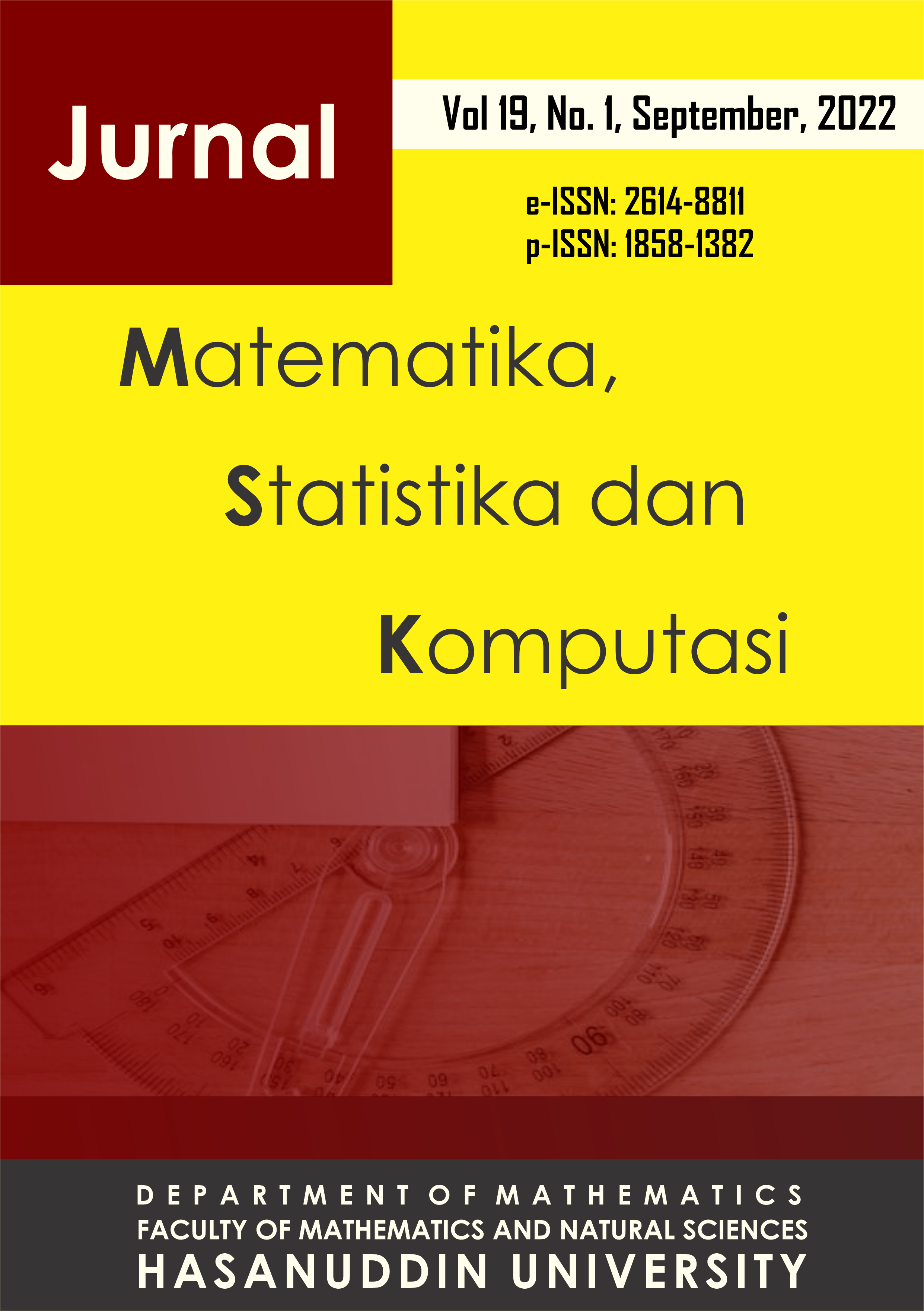Tuberculosis Modeling in East Java Based on Geographically Weighted Regression Approach
DOI:
https://doi.org/10.20956/j.v19i1.21262Keywords:
Tuberculosis, Linear Regression, Geographically Weighted RegressionAbstract
Tuberculosis is the 13th trigger of death causes around the world. Even after Covid-19, tuberculosis ranks 2nd as a contagious killer disease. In 2020, Indonesia ranks 2nd out of 8 countries with the highest contributor to tuberculosis sufferers after India. East Java Province is the region with the largest number of tuberculosis cases in order of 8. Tuberculosis cases in East Java in 2020 have decreased, but when viewed from the success rate of treatment of tuberculosis cases per district/city in East Java, it was found that 53% still did not meet the target of 90%. According to (World Health Organization), gender affects the occurrence of tuberculosis disease, where men are more susceptible than women. In finding treatment for all tuberculosis incidents in East Java, the highest patient was male. This study was conducted to model tuberculosis in men in the East Java area. The results of the study prove that the modeling of male tuberculosis in East Java used linear regression and GWR (Geographically Weighted Regression) obtained the best model was GWR with Fixed Gaussian Kernel weighting, CV value of 5.68, and R2 86.47%. Variables that have a significant effect on male tuberculosis in East Java are BCG immunization for male infants, public places meeting health requirements, youth who smoke tobacco every day, sex ratio, and households with access to proper sanitation facilities.
References
BPS. 2020. Indikator Tujuan Pembanguan Berkelanjutan Indonesia 2020. Badan Pusat Statistik, Jakarta. https://www.bps.go.id/publication/2020/12/17/7a6c6ad8f95681d0050e7d89/indikator-tujuan-pembangunan-berkelanjutan--tpb--indonesia-2020.html0. [12 Agustus 2021]
Dinas Kesehatan Provinsi Jawa Timur. 2021. Profil Kesehatan Jawa Timur 2020. Dinas Kesehatan Provinsi Jawa Timur, Surabaya. https://dinkes.jatimprov.go.id/userfile/dokumen/PROFIL%20KESEHATAN%202020.pdf. [11 Agustus 2021]
Fotheringham, A. S., Brunsdon, C. dan Charlton, M. E., 2002. Geographically Weighted Regression: The Analysis of Spatially Varying Relationship. John Wiley & Sons Inc., New York.
Gujarati, D. N., 2004. Basic Econometrics, 4th Edition. McGraw-Hill., New York.
Infodatin. 2018. Tuberkulosis. Kementerian Kesehatan Republik Indonesia. https://pusdatin.kemkes.go.id/resources/download/pusdatin/infodatin/infodatin-tuberkulosis-2018.pdf. [27 Agustus 2021]
Kemenkes RI. 2020. Strategi Nasional Penanggulangan Tuberkulosis di Indonesia 2020-2024. Kementerian Kesehatan Republik Indonesia. https://tbindonesia.or.id/wp-content/uploads/2021/06/NSP-TB-2020-2024-Ind_Final_-BAHASA.pdf. [12 September 2021]
Lee, J. & Wong, D. W. S., 2001. Statistical Analysis with Arcview GIS. John Wiley & Sons Inc., New York.
LeSage, J.P. & Bernard, C. A., 2011. Quantifying Knowledge Spillovers Using Spatial Econometric Tools. Boca Ration R Press, New York.
Mumtaz, T., & Utomo, A., P., 2018. Modelling The Number Of New Pulmonary Tuberculosis Cases with Geographically Weighted Binomial Regression Method. Indonesian Journal of Statistics and Its Applications. Vol 2, No 2, 77-92.
Narasimhan, P., Wood, J., MacIntyre, C.R. & Mathai, D., 2013. Risk Factors for Tuberculosis. Pulmonary Medicine. Vol 2013, 1-11.
Noorcintanami, S., Widyaningsih, Y., dan Abdullah, S. 2021. Geographically weighted models for modelling the prevalence of tuberculosis in Java. Journal of Physics: Conference Series, 240th ECS Meeting, Digital Meeting, October 10-14.
Razali, N. M. dan Wah, Y. B. 2011. Power comparisons of Shapiro-Wilk, Kolmogorov-Smirnov, Lilliefors and Anderson-Darling tests. Journal of Statistical Modeling and Analytics. Vol 2, No 1, 21-33.
Rencher, A. C., dan Schaalje, G. B., 2008. Linier Models in Statistics, Second Edition. John Wiley & Sons Inc., New York.
Rizky, H. P., Pramesti, W., dan Anuraga, G., 2020. Penggunaan Analisis Klaster K-Means dalam Pemodelan Regresi Spasial Pada Kasus Tuberkulosis di Jawa Timur Tahun 2017. Indonesian Journal of Statistics and Its Applications. Vol 4, No 1, 164-178.
TB Indonesia. 2020. Dashboard TB. Kementerian Kesehatan Republik Indonesia. https://tbindonesia.or.id/pustaka-tbc/dashboard-tb/. [14 September 2021]
Ugarte-Gill, C., Alisjahbana, B., Ronacher, K., Riza, A. L., Koesoemadinata, R. C., Malherbe, S, T., Ciobota, R., Llontop, J. C., Kleynhans, L., Lopez, S., Santoso, P., Marius, C., Villaizan, K., Ruslami, R., Walzl, G., Panduru, N. M., Dpckrell, H. M., Hill, P. C., Allister, S. Mc., Pearson, F., Moore, D. A. J., Critchley, J. A., Crevel, R. V., 2019. Diabetes Mellitus Among Pulmonary Tuberculosis Patients From 4 Tuberculosis-endemic Countries: The TANDEM Study. Clinical Infectious Diseases. Vol 70, No 5, 780-788.
WHO, 2021. Tuberculosis. World Health Organization. https://www.who.int/news-room/fact-sheets/detail/tuberculosis. [20 September 2021]
Downloads
Published
How to Cite
Issue
Section
License
Copyright (c) 2022 Author and publisher

This work is licensed under a Creative Commons Attribution 4.0 International License.

This work is licensed under a Creative Commons Attribution 4.0 International License.
Jurnal Matematika, Statistika dan Komputasi is an Open Access journal, all articles are distributed under the terms of the Creative Commons Attribution License, allowing third parties to copy and redistribute the material in any medium or format, transform, and build upon the material, provided the original work is properly cited and states its license. This license allows authors and readers to use all articles, data sets, graphics and appendices in data mining applications, search engines, web sites, blogs and other platforms by providing appropriate reference.







